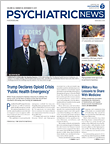At last month’s IPS meeting, I had the opportunity to join APA President-elect Altha Stewart, M.D., APA CEO and Medical Director Saul Levin, M.D., M.P.A., and dozens of my APA colleagues at a session that is part of APA’s “Conversations on Diversity” series.
Since 2015, APA’s Division of Diversity and Health Equity (DDHE) has sponsored “Conversations” at APA Annual Meetings and the IPS: The Mental Health Services Conference. These sessions provide a setting in which attendees of all backgrounds can share their experiences and perspectives about diversity, cultural sensitivity, and inclusion. Information from the sessions helps APA set objectives and create programs to increase engagement of minority and underrepresented psychiatrists within our organization and ensure equal access to high-quality psychiatric care—health equity—for all patients regardless of race/ethnicity, age, religion, nationality, sexual orientation, gender identity, socioeconomic status, or geographical background. It is important that we not only continue but step up our efforts in this area because of the increase in diversity among our members and patients and, unfortunately, the ongoing discrimination against members of minorities in our country.
Helena Hansen, M.D., Ph.D., vice chair of APA’s Council on Minority Mental Health and Health Disparities, served as the guest facilitator of the IPS session, titled “Increasing Diversity Within APA While Working to End Mental Health Disparities.” While the title suggests two distinct goals, Dr. Hansen expertly pointed out that there is great synergy and overlap between the internal and external. If we are to work for common causes as an organization, we need to know each other and trust each other.
During the IPS session, participants—who ranged from senior psychiatrists to medical students with an interest in psychiatry—were divided into small groups to spark conversations around the following questions:
•
What is diversity, and how can it be promoted by APA?
•
How can APA promote the well-being of minority and underrepresented (M/UR) psychiatrists?
•
How can M/UR psychiatrists support each other?
•
How can M/UR psychiatrists work individually and together to meet the needs of an increasingly diverse patient population?
•
How do you define “intersectionality”?
•
What can APA do to help reduce stigma and bring attention to the impact of trauma within marginalized communities?
As the small group meetings ended and attendees reconvened to discuss their responses, I was impressed by the recommendations they made to further promote involvement of minority and psychiatrists in APA and strategies to reduce mental health disparities. Some of the goals that the groups identified included making it explicit that diversity is a “core value” of APA and enhancing efforts to encourage all psychiatrists to receive training to improve skills in cross-cultural care and in addressing institutional and community-level causes of mental health care inequalities. Session participants viewed this kind of training as necessary to help eliminate inequities that result in patients from minority and underserved groups’ not having access to the mental health care they need.
Other recommendations included logistical matters like scheduling the meetings of the M/UR caucuses during the Annual Meeting in such a way that APA members can attend more than one. Many M/UR individuals identify with more than one group—such multiple identities are often termed “intersectionality”—and the current schedule forces them to pick one identity as the most important.
I left the session energized about APA’s commitment to diversity issues. Ranna Parekh, M.D., and her DDHE team have a tremendous amount of feedback to review, and I will work with them to identify areas in which we need to put more attention and resources.
I encourage all our members to attend the “Conversations on Diversity” session at APA’s 2018 Annual Meeting in New York City next May. Each one of us has a story about our own experiences to contribute to the conversation and help us move forward. ■

